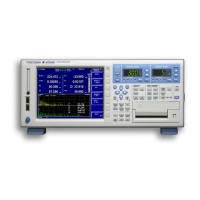7-42
IM WT3001E-51EN
Determination of Measurement Functions during Harmonic Measurement
P(k)
S(k)
dc
(when k = 0)
1
(when k = 1)
k
(When k = 2 to max)
Characters/Numbers inside the parentheses of
measurement functions
I
r(k)
2
+ Ij(k)
2
I(dc) = Ir(0)
I(k) =
U
r(k)
2
+ Uj(k)
2
Voltage U( ) [V]
Current I( ) [A]
U(dc) =U
r(0)
U(k) =
Active power P( ) [W]
P(dc) = U
r(0) • Ir(0) P(k) = Ur(k) • Ir(k) + Uj(k) • Ij(k)
S(dc) = P(dc)
Reactive power Q( ) [var]
(TYPE3)*
Apparent power S( ) [VA]
(TYPE3)*
Q(k) = U
r(k) • Ij(k) – Uj(k) • Ir(k)
Q(dc) = 0
S(k) = P(k)
2
+ Q(k)
2
Power factor λ( )
Phase difference φ( ) [°]
Phase difference with respect to U(1)
φU( ) [°]
Phase difference with respect to I(1)
φI( ) [°]
φU(k) = Phase difference of U(k)
with respect to U(1)
φI(k) = Phase difference of I(k)
with respect to I(1)
λ(k) =
Impedance of the load circuit
Z( ) [Ω]
U(dc)
I(dc)
Z(dc) =
U(k)
I(k)
Z(k) =
Series resistance of the load circuit
Rs( ) [Ω]
P(k)
I(k)
2
P(dc)
I(dc)
2
Rs(dc) =
Rs(k) =
Series reactance of the load circuit
Xs( ) [Ω]
Q(k)
I(k)
2
Q(dc)
I(dc)
2
Xs(dc) =
Xs(k) =
Parallel resistance of the load circuit
Rp( ) [Ω] (= 1/G)
U(k)
2
P(k)
U(dc)
2
P(dc)
Rp(dc) =
Rp(k) =
Parallel reactance of the load circuit
Xp( ) [Ω] (= 1/B)
U(k)
2
Q(k)
U(dc)
2
Q(dc)
Xp(dc) =
Xp(k) =
Measurement Functions during
Harmonic Measurement
Method of Determination, Equation
(Table 1/3)
(Continues on the next page)
λ(dc) =
P(dc)
S(dc)
Total {No ( )}
S = P
2
+ Q
2
U(k)
2
k = min
max
U =
I(k)
2
k = min
max
I =
P(k)
k = min
max
P =
Q(k)
k = min
max
Q =
P
λ =
S
φ(k) = ATAN2{P(k), Q(k)} φ = ATAN2{P, Q}
Regarding ATAN2{x,y} in the equation above:
y
x
When x > 0, tan
–1
{ }
y
x
When x < 0 and y > 0, tan
–1
{ }
+ 180°
y
x
When x < 0 and y < 0, tan
–1
{ }
- 180°
* For details on the type of S and Q equations, see section 5.9 in the User’s Manual IM WT3001E-01EN.
Note
• Variables k, r, and j denote the harmonic order, real part, and imaginary part, respectively.
• Variables U(k), Ur(k), Uj(k), I(k), Ir(k), and Ij(k) are expressed using rms values.
• min denotes the minimum order. You can select 0 (DC component) or 1 (fundamental signal
component) for the minimum order. For details, see section 7.5.
• Variable max is the upper limit of measured order. The upper limit is determined
automatically (maximum is 100) by the frequency of the PLL source.
7.11 Harmonic Measurement Specifications

